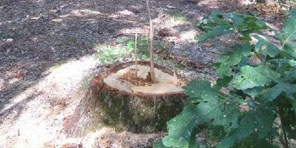ROLLA, Mo.— A recent investigation of illegal tree harvesting on the Mark Twain National Forest that led to the indictment of a southern Missouri man used an uncommon form of evidence—DNA from an illegally harvested log. This case marks the first time that tree DNA was used to investigate a federal timber poaching case in the eastern United States.
Timber theft is a common crime on public lands. Black walnut—the tree in this case—is among the largest and longest-lived hardwood tree species growing on the Mark Twain’s 1.5 million acres. Its wood is sought after for veneers and furniture, which makes it an attractive target for timber poaching on federal and other lands across Missouri and neighboring states.
Patrol Captain Casey Hutsell oversees law enforcement on Mark Twain National Forest. Hutsell stated, “Timber theft investigation is a priority for Forest Service Law Enforcement and Investigations on the Mark Twain National Forest, and I’m excited because using DNA evidence gives us another great tool in our toolbox to combat the theft of natural resources from public lands.”
In October 2019, witnesses notified a law enforcement officer of a potential illegal harvest on the forest near Siloam Springs, Mo. After identifying eight freshly cut walnut stumps at the site, a Forest Service special agent was assigned the case. He investigated a nearby hardwood lumber mill, where he found one log with dimensions matching one of the stumps. An off-cut from the end of the suspect log showed a near-perfect fit to one of the freshly cut stumps at the theft site. To convincingly prove that this stump and log represented the same tree, the special agent contacted Richard Cronn, a USDA Forest Service research geneticist based in Oregon, who studies forest tree genetics and has pioneered the use of tree DNA in illegal logging investigations.
“Coincidentally, our lab was developing a DNA test to identify individual black walnut trees at the Forest Service’s Hardwood Tree Improvement and Regeneration Center,” Cronn said. “There’s an enormous interest in selectively breeding black walnut to improve growth characteristics of the tree. Because of this project, we were able to quickly meet this request.”
Cronn’s lab evaluated the stump and log samples utilizing the new test, and results showed that the samples were identical across 80 genetic markers—an unambiguous genetic match.
“With any DNA forensic test, it’s essential to answer how likely is it that two random trees could show the same DNA profile. We answer this using a DNA database,” Cronn said.
For Missouri black walnut, that DNA database was built by Forest Service law enforcement and timber staff and Adventure Scientists, a citizen-science volunteer organization. The group’s volunteers collected leaf and wood samples across the species’ range, and Forest Service geneticists analyzed the samples to determine the “DNA profile probability’—or the chance that two random walnut trees would share the same DNA fingerprint.
Using this database, the research team determined that the DNA profile probability for the illegally cut tree was less than one in a million-trillion-trillion. The combination of physical evidence and DNA testing proved irrefutable.
The defendant pled guilty in July 2023 to one felony count of depredation of Government property (18 U.S.C. § 1361), and was sentenced to five months of time served, a 3-year supervised release, and restitution for the value of timber and ecological damage to the forest.
This case has important implications for future Forest Service investigations. Tree DNA sequences, just like human fingerprints, are unique to each tree. These unique DNA fingerprints can be found in all parts of a tree, including leaves, buds, flowers, fruit, and wood. Historically, it has been nearly impossible to match milled lumber to the stump of an illegally harvested tree, but this DNA fingerprinting now allows stumps to be matched to cut logs, milled lumber, mill waste, and, even, some finished wood products.
With this new database, DNA fingerprinting can be used to investigate walnut theft across the growing range of the species, which spans 32 states. Forest Service geneticists and Adventure Scientists are building additional DNA databases for other targets of timber poaching, including eastern white oak from the eastern U.S. and bigleaf maple, western redcedar, and Douglas-fir from the Pacific Northwest.
“This work is a great merger of basic and applied research, and it significantly expands the tool kit that federal law enforcement can use to investigate timber theft,” Cronn said.

